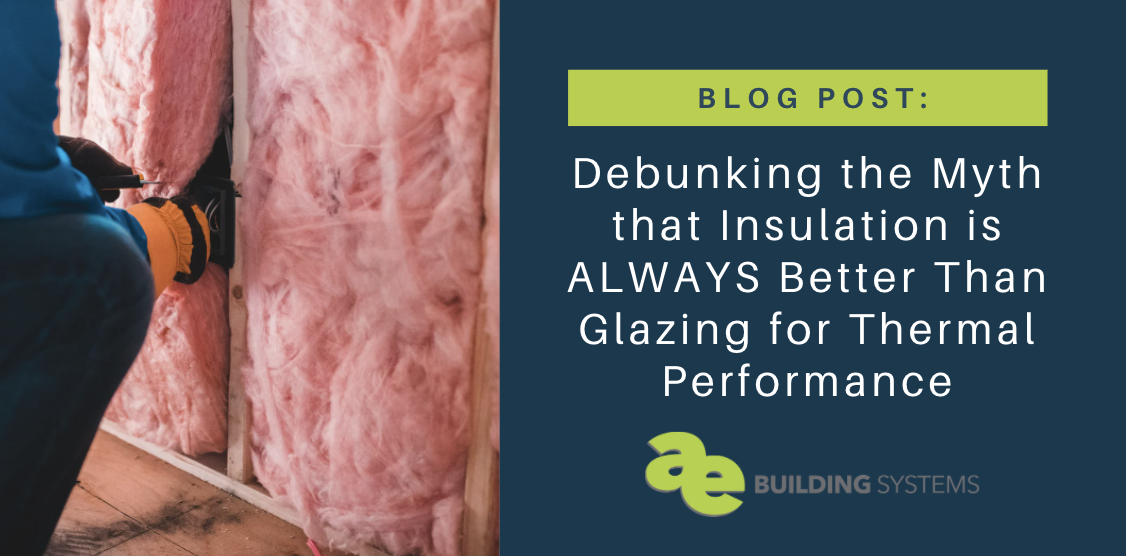The immediate place our minds go when it comes to improving the performance of a wall is to insulate. That seems to be the easiest and simplest approach to improving performance and energy efficiency. But, what if we told you the glazing is where you really get the bigger bang for your buck? Would you be surprised?
Most people are, and note we are assuming more standard residential construction and assumptions include 2X framing and batt insulation. Construction with steel studs, concrete, continuous insulation, thermal bridging, etc. alter the results in different ways.
A window is essentially a thermal “hole in the dike,” and insulation in walls above certain R-Values becomes less and less helpful when looking at the overall performance of the wall – window included.
Okay, so we can all get behind the idea that insulation in the walls is a good thing, and surely it’s effective for energy-efficiency. Is it not a pretty bold statement to say that glazing is MORE effective?
Hang on with us…
Gazing at Glazing Options:
We have single pane glass, which keeps out the elements and is worthless in terms of thermal performance. We don’t see these in modern construction, especially in sustainable, energy-efficient projects.
Many homes have dual-pane insulating glass, which is two glass panes with a low-e coating, separated by a small sealed air space. When inserted with a gas like argon, it increases its insulation. You can see maximum performance ratings up to about R-4 with most options landing around R-3.5.
Other windows feature triple-pane insulated glass, which increases that dual-pane concept by an extra pane and an extra insulated chamber. Triple-pane (the glass IGU specifically) can be up to 50 percent heavier, difficult to handle, and require stronger supports. However, you can get insulating properties up to R-10 center of glass (COG).
On standard walls, we might be lucky to see an R-20 effective R-Value, but in many commercial curtain wall systems, “high performance” can often be categorized as an R-4 wall. A simple look at the numbers above shows the very high-level understanding that if you go the route of energy-efficient windows, you can achieve similar, if not better, performance than a curtain-wall system. In residential wall assemblies like 2×6 construction, effective R-Values run R-10 to R-14 as there is thermal bridging in the 2×6. This is a whole different topic and we’re going to stick to a basic wall R-value.
Okay, high-performance windows are great, but couldn’t you just beef up the insulation to compensate for lesser-performing windows?
Let’s do some math:
Let’s suppose a facade is 75% wall and 25% glazed. The wall part is R-20, and the window is at R-3. In this situation, the thermal performance of the overall wall with windows is roughly R-8.3.
Now, if you double the performance of the wall portion to R-40 (keeping the window at R-3), the R-value for the overall wall (windows included) is slightly better at just R-9.8, so not much difference compared to where we started. You’d think that 100% increase in wall R-value would yield more than an 18% improvement in the overall wall – windows included.
BUT, what if we changed out the windows and doubled their performance to be R-6 (and kept the wall portion at R-20)? If you do that, and re-run the calculations, you actually get an overall wall performance of R-12.6! At 53%, that’s a pretty high percentage increase.
Oh… by the way… going to R-40 walls and R-6 windows takes the overall wall R-value to R-16.5, and R-40 walls and R-9 windows takes the overall wall to R-21.5. However, R-60 walls and R-3 glass is around R-10.5 Glazing is truly the weak link in our wall assemblies.
Watch this video by Todd going into more detail on frame types, triple vs. quad panes, spacer options, and gas types.
While it feels counterintuitive, going for the high-performing windows actually moves the needle further than beefing up insulation in the wall itself. Curious about what kind of high-performance windows are right for your project? Talk to our team about maximizing your overall R-values. We LOVE sharing our knowledge to help you make the right decision for your next project!
This project has R-7 to R-9 fenestration products and approximately R-40 walls.
:


Interesting presentation. I learned something new today. Thank you!
Fantastic math! Thank you Todd for breaking this down into simple and easy to understand language. I’ll send all our clients to this blog before we talk about windows and walls! And the video is a perfect introduction to high performing windows. Thank you!
Thanks Peter… That means a lot coming from you. As you know, it is a simplification of a much more complex calculation. The goal was just that – keep it simple.